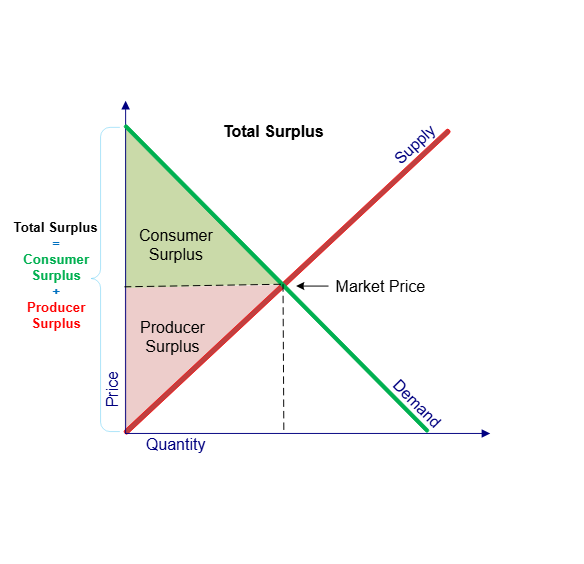
Surplus
Individual surplus is the difference between the price of a good and the maximum
an individual is willing to pay, which depends on their marginal benefit from the good. But when you combine all the individual consumer surpluses in a given market, the result is consumer surplus, the difference between the total value to consumers and the total market value.
Let’s imagine a toy costs $50. Jack is willing to pay a maximum of $80, John will pay $60, and Jeff will pay $40 at max.
- Jack’s surplus: 80 - 50 = 30
- John’s surplus: 60 - 50 = 10
- Jeff’s surplus: N/A because he buy the toy
The resulting total consumer surplus is $30 + $10 = $40. Starting to see how it works? How much surplus you get is kind of like “how good of a deal is this purchase?” When the price of a good decreases, total consumer surplus will definitely go up. That’s because you’re now adding the surplus of new consumers who would be willing to pay at that price. At the same time, you’re increasing the existing surplus of the current consumers who were already willing to pay.
Going back to the toy example; imagine the price dropped to $30.
- Jack’s surplus: 80 - 30 = 50
- John’s surplus: 60 - 30 = 30
- Jeff’s surplus: 40 - 30 = 10
The new resulting total consumer surplus, summing the consumers’ individual surpluses, is $50 + $30 + $10 = $90. Graphically, the area between the price line and the demand curve got bigger.
But where is all this consumer surplus coming from? Well, it trades off with producer surplus, which is a very similar concept. The individual surplus for producers is the difference between the price of goods and the lowest price a producer would be willing to sell a good. Total producer surplus is the difference between total market value and total cost of production.
Following the law of supply, an increase in price adds surplus to current producers while also creating new surplus from producers who now enter the market due to the higher price. Graphically, producer surplus is the area between the price line and the supply curve.
Taking all of this into account, it's also important to recognize that total surplus – including both producers and consumers – is maximized at equilibrium. At equilibrium, no mutually beneficial
transactions are missed, and no non-beneficial transactions are forced; there is no DWL to take away from surplus. Effective (which is just another way to say binding) price or quantity controls create DWL, which takes away from surplus.
Source: This Matter
